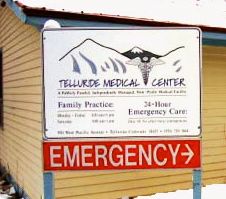
28 Jun Medical Moment: Seasonal Allergies
Telluride Inside… and Out is proud to feature the Telluride Medical Center’s MEDICAL MOMENT, a weekly column that answers common medical questions in pop culture. Have a question for the doctors? Click here to send.
Laura A. Cattell, PA-C answer this week’s question:
WHAT CAN I DO ABOUT SEASONAL ALLERGIES?
It’s finally summer in Telluride and with that comes allergic rhinitis, aka “Hay Fever.”
Allergic rhinitis is an inflammation of the nasal passages and can cause sneezing, itching, nasal congestion, runny nose and post nasal drip. Other symptoms of hay fever include itchy, watery, swollen eyes, scratchy itchy throat and ears and possible mouth breathing effecting sleep.
Approximately 20% of the population is affected by hay fever; it can affect all ages, and usually begins in childhood and young adults. The severity of symptoms may vary throughout life, some people may experience periods with no symptoms at all only to have them return.
Treatment:
1) Reduce exposure to triggers
• Shower before bed to remove allergens from hair and skin
• Use of high quality mask when performing activities like cutting grass or wood cutting
• Consider closing windows and staying indoors at peak times
DID YOU KNOW? The American Academy of Allergy, Asthma, and Immunology has a toll free number (1-800-976-5536) and website that monitors pollen and mold spore counts.
2) Nasal irrigation: rinsing of the nose with a saline solution (at least 8ozs)
•Helps rinse out allergens and irritants
• Cleanses nasal lining and is good to use prior to nasal sprays
Nasal Irrigation Recipe:
1 quart distilled or boiled water
1-1.5 tsp of pickling/canning salt (table salt contains additives)
1 tsp of baking soda
Mix ingredients together, store at room temperature
(Discard mixture after 1 week)
Place at least 8oz in squeeze bottle, Neti pot or water pick with irrigation tip.
Rinse nose over sink, bend over and squirt solution into each nostril, aim stream towards back of head, the solution should flow in one nostril and out the other.
Perform 1-2 times a day.
3) Antihistamines: can relieve the itching, sneezing, and runny nose, but they do not relieve nasal congestion. Combined use with a decongestant may provide greater symptoms relief.
• All are over the counter. Non sedating include, Claritin, Zyrtec, and Allegra
• Used daily and proactively they can be very effective
• They can be combined with a decongestant; decongestants can raise blood pressure and increase your heart rate.
4) Steroid Nasal Sprays
• Considered FIRST line treatment for hay fever
• Require a prescription
• Studies show more effective then antihistamines for hay fever
• Best if used regularly/daily
• Very few side effects, when inhaled very little of the steroid enters the blood stream
5) Allergy Shots: injections given to reduce a person’s sensitivity to allergens
•Usually for people who don’t respond to medical therapy
• May prevent children from progressing to asthma
• Expensive and time consuming but effective.
Bottom line: There are a lot of effective treatments for hay fever!
Editor’s note: The Telluride Medical Center is the only 24-hour emergency facility within 65 miles. As a mountain town in a challenging, remote environment, a thriving medical center is vital to our community’s health.
For more Medical Moments on TIO, Click Here.




Sorry, the comment form is closed at this time.